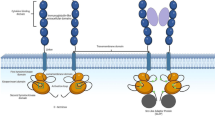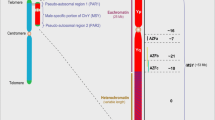Abstract
Purpose
The MRE11-RAD50-NBN (MRN) complex plays a key role in recognizing and signaling DNA double-strand breaks. Pathogenic variants in NBN and MRE11 give rise to the autosomal-recessive diseases, Nijmegen breakage syndrome (NBS) and ataxia telangiectasia-like disorder, respectively. The clinical consequences of pathogenic variants in RAD50 are incompletely understood. We aimed to characterize a newly identified RAD50 deficiency/NBS-like disorder (NBSLD) patient with bone marrow failure and immunodeficiency.
Methods
We report on a girl with microcephaly, mental retardation, bird-like face, short stature, bone marrow failure and B-cell immunodeficiency. We searched for candidate gene by whole-exome sequencing and analyzed the cellular phenotype of patient-derived fibroblasts using immunoblotting, radiation sensitivity assays and lentiviral complementation experiments.
Results
Compound heterozygosity for two variants in the RAD50 gene (p.Arg83His and p.Glu485Ter) was identified in this patient. The expression of RAD50 protein and MRN complex formation was maintained in the cells derived from this patient. DNA damage-induced activation of the ATM kinase was markedly decreased, which was restored by the expression of wild-type (WT) RAD50. Radiosensitivity appeared inconspicuous in the patient-derived cell line as assessed by colony formation assay. The RAD50R83H missense substitution did not rescue the mitotic defect in complementation experiments using RAD50-deficient fibroblasts, whereas RAD50WT did. The RAD50E485X nonsense variant was associated with in-frame skipping of exon 10 (p.Glu485_545del).
Conclusion
These findings indicate important roles of RAD50 in human bone marrow and immune cells. RAD50 deficiency/NBSLD can manifest as a distinct inborn error of immunity characterized by bone marrow failure and B-cell immunodeficiency.




Similar content being viewed by others
Data Availability
The datasets for this article are not publicly available due to concerns regarding participant/patient anonymity. Requests to access the datasets should be directed to the corresponding author.
Abbreviations
- AT:
-
Ataxia telangiectasia
- ATLD:
-
Ataxia telangiectasia-like disorder
- DSB:
-
DNA double-strand break
- IEI:
-
Inborn error of immunity
- MRN:
-
MRE11-RAD50-NBN
- NBS:
-
Nijmegen breakage syndrome
- NBSLD:
-
NBS-like disorder
- WES:
-
Whole-exome sequencing
- WT:
-
Wild-type
References
Syed A, Tainer JA. The MRE11–RAD50–NBS1 complex conducts the orchestration of damage signaling and outcomes to stress in DNA replication and repair. Annu Rev Biochem. 2018;87:263–94.
Kashimada A, Hasegawa S, Nomura T, Shiraku H, Moriyama K, Suzuki T, et al. Genetic analysis of undiagnosed ataxia-telangiectasia-like disorders. Brain Dev. 2019;41:150–7.
Rahman S, Canny MD, Buschmann TA, Latham MP. A survey of reported disease-related mutations in the MRE11-RAD50-NBS1 complex. Cells. 2020;9:1678.
Sharapova SO, Pashchenko OE, Bondarenko AV, Vakhlyarskaya SS, Prokofjeva T, Fedorova AS, et al. Geographical distribution, incidence, malignancies, and outcome of 136 eastern slavic patients with Nijmegen breakage syndrome and NBN founder variant c.657_661del5. Front Immunol. 2021;11:602482.
McCarthy-Leo C, Darwiche F, Tainsky MA. DNA repair mechanisms, protein interactions and therapeutic targeting of the MRN complex. Cancers. 2022;14:5278.
Waltes R, Kalb R, Gatei M, Kijas AW, Stumm M, Sobeck A, et al. Human RAD50 deficiency in a Nijmegen breakage syndrome-like disorder. Am J Hum Genet. 2009;84:605–16.
Ragamin A, Yigit G, Bousset K, Beleggia F, Verheijen FW, Wit MY, et al. Human RAD50 deficiency: confirmation of a distinctive phenotype. Am J Med Genet. 2020;182:1378–86.
Chansel-Da Cruz M, Hohl M, Ceppi I, Kermasson L, Maggiorella L, Modesti M, et al. A disease-causing single amino acid deletion in the coiled-coil domain of RAD50 impairs MRE11 complex functions in yeast and humans. Cell Rep. 2020;33: 108559.
Hoshino A, Takashima T, Yoshida K, Morimoto A, Kawahara Y, Yeh T-W, et al. Dysregulation of Epstein-Barr virus infection in hypomorphic ZAP70 mutation. J Infect Dis. 2018;218:825–34.
Brandes N, Goldman G, Wang CH, Ye CJ, Ntranos V. Genome-wide prediction of disease variant effects with a deep protein language model. Nat Genet. 2023. https://doi.org/10.1038/s41588-023-01465-0. Online ahead of print.
Shin B, Ahn K, Kook H, Koh J, Kang I, Lee H, et al. Overexpressed human RAD50 exhibits cell death in a p21(WAF1/CIP1)-dependent manner: its potential utility in local gene therapy of tumor. Cell Growth Differ. 2001;12:243–54.
Völkening L, Vatselia A, Asgedom G, Bastians H, Lavin M, Schindler D, et al. RAD50 regulates mitotic progression independent of DNA repair functions. FASEB J. 2020;34:2812–20.
Schröder-Heurich B, Wieland B, Lavin MF, Schindler D, Dörk T. Protective role of RAD50 on chromatin bridges during abnormal cytokinesis. FASEB J. 2014;28:1331–41.
Bender CF, Sikes ML, Sullivan R, Huye LE, Le Beau MM, Roth DB, et al. Cancer predisposition and hematopoietic failure in Rad50 S/S mice. Genes Dev. 2002;16:2237–51.
Delia D, Mizutani S, Panigone S, Tagliabue E, Fontanella E, Asada M, et al. ATM protein and p53-serine 15 phosphorylation in ataxia-telangiectasia (AT) patients and at heterozygotes. Br J Cancer. 2000;82:1938–45.
Roth S, Rottach A, Lotz-Havla AS, Laux V, Muschaweckh A, Gersting SW, et al. Rad50-CARD9 interactions link cytosolic DNA sensing to IL-1β production. Nat Immunol. 2014;15:538–45.
Kamae C, Nakagawa N, Sato H, Honma K, Mitsuiki N, Ohara O, et al. Common variable immunodeficiency classification by quantifying T-cell receptor and immunoglobulin κ-deleting recombination excision circles. J Allergy Clin Immunol. 2013;131:1437–40.
Wolska-Kuśnierz B, Gregorek H, Chrzanowska K, Piątosa B, Pietrucha B, Heropolitańska-Pliszka E, et al. Nijmegen breakage syndrome: clinical and immunological features, long-term outcome and treatment options – a retrospective analysis. J Clin Immunol. 2015;35:538–49.
Luo G, Yao MS, Bender CF, Mills M, Bladl AR, Bradley A, et al. Disruption of mRad50 causes embryonic stem cell lethality, abnormal embryonic development, and sensitivity to ionizing radiation. Proc Natl Acad Sci U S A. 1999;96:7376–81.
Adelman CA, De S, Petrini JHJ. Rad50 is dispensable for the maintenance and viability of postmitotic tissues. Mol Cell Biol. 2009;29:483–92.
Demuth I, Frappart P-O, Hildebrand G, Melchers A, Lobitz S, Stöckl L, et al. An inducible null mutant murine model of Nijmegen breakage syndrome proves the essential function of NBS1 in chromosomal stability and cell viability. Hum Mol Genet. 2004;13:2385–97.
Shimada H, Shimizu K, Mimaki S, Sakiyama T, Mori T, Shimasaki N, et al. First case of aplastic anemia in a Japanese child with a homozygous missense mutation in the NBS1 gene (I171V) associated with genomic instability. Hum Genet. 2004;115:372–6.
Chrzanowska KH, Gregorek H, Dembowska-Bagińska B, Kalina MA, Digweed M. Nijmegen breakage syndrome (NBS). Orphanet J Rare Dis. 2012;7:13.
Stinson BM, Loparo JJ. Repair of DNA double-strand breaks by the nonhomologous end joining pathway. Annu Rev Biochem. 2021;90:137–64.
Lee J-H, Paull TT. Activation and regulation of ATM kinase activity in response to DNA double-strand breaks. Oncogene. 2007;26:7741–8.
Daniel JA, Pellegrini M, Lee J-H, Paull TT, Feigenbaum L, Nussenzweig A. Multiple autophosphorylation sites are dispensable for murine ATM activation in vivo. J Cell Biol. 2008;183:777–83.
Hohl M, Mojumdar A, Hailemariam S, Kuryavyi V, Ghisays F, Sorenson K, et al. Modeling cancer genomic data in yeast reveals selection against ATM function during tumorigenesis. PLoS Genet. 2020;16: e1008422.
Pellegrini M, Celeste A, Difilippantonio S, Guo R, Wang W, Feigenbaum L, et al. Autophosphorylation at serine 1987 is dispensable for murine Atm activation in vivo. Nature. 2006;443(7108):222–5.
Acknowledgements
We thank Mika Nagase and Girmay Asgedom for their technical assistance, Louisa Weinhold and Katja Bezjak for scientific assistance, Detlev Schindler for support with large T immortalized cell lines and Axel Schambach for support in setting up the lentiviral complementation system.
Funding
This study was supported by the Research on Measures for Intractable Disease Project to SK, the Claudia von Schilling Foundation for Breast Cancer Research to TD, and MEXT/JSPS KAKENHI (Grant Number: 22K07887) to HK.
Author information
Authors and Affiliations
Contributions
MT designed and performed experiments and analyzed the data. AH, KB, JR, HLM, IF, DT, XY and JK performed experiments and analyzed the data. NS provided the patient data. KY, SM and SO performed genetic analysis. MT, AH, TD and HK wrote the manuscript. SK and TM provided critical discussion. TD and HK conceptualized the study. All authors read and approved the final manuscript.
Corresponding authors
Ethics declarations
Ethics Approval
This study was performed in line with the principles of the Helsinki Declaration. Approval was granted by the Tokyo Medical and Dental University Ethics Committee (protocol no. 103).
Consent to Participate
Informed consent was obtained from the patient and her parents.
Consent for Publication
Informed consent was obtained from the patient and her parents.
Conflict of Interest
The authors declare no competing interests.
Additional information
Publisher’s Note
Springer Nature remains neutral with regard to jurisdictional claims in published maps and institutional affiliations.
Thilo Dörk and Hirokazu Kanegane share senior authorship.
Supplementary Information
Below is the link to the electronic supplementary material.
Rights and permissions
Springer Nature or its licensor (e.g. a society or other partner) holds exclusive rights to this article under a publishing agreement with the author(s) or other rightsholder(s); author self-archiving of the accepted manuscript version of this article is solely governed by the terms of such publishing agreement and applicable law.
About this article
Cite this article
Takagi, M., Hoshino, A., Bousset, K. et al. Bone Marrow Failure and Immunodeficiency Associated with Human RAD50 Variants. J Clin Immunol 43, 2136–2145 (2023). https://doi.org/10.1007/s10875-023-01591-8
Received:
Accepted:
Published:
Issue Date:
DOI: https://doi.org/10.1007/s10875-023-01591-8




